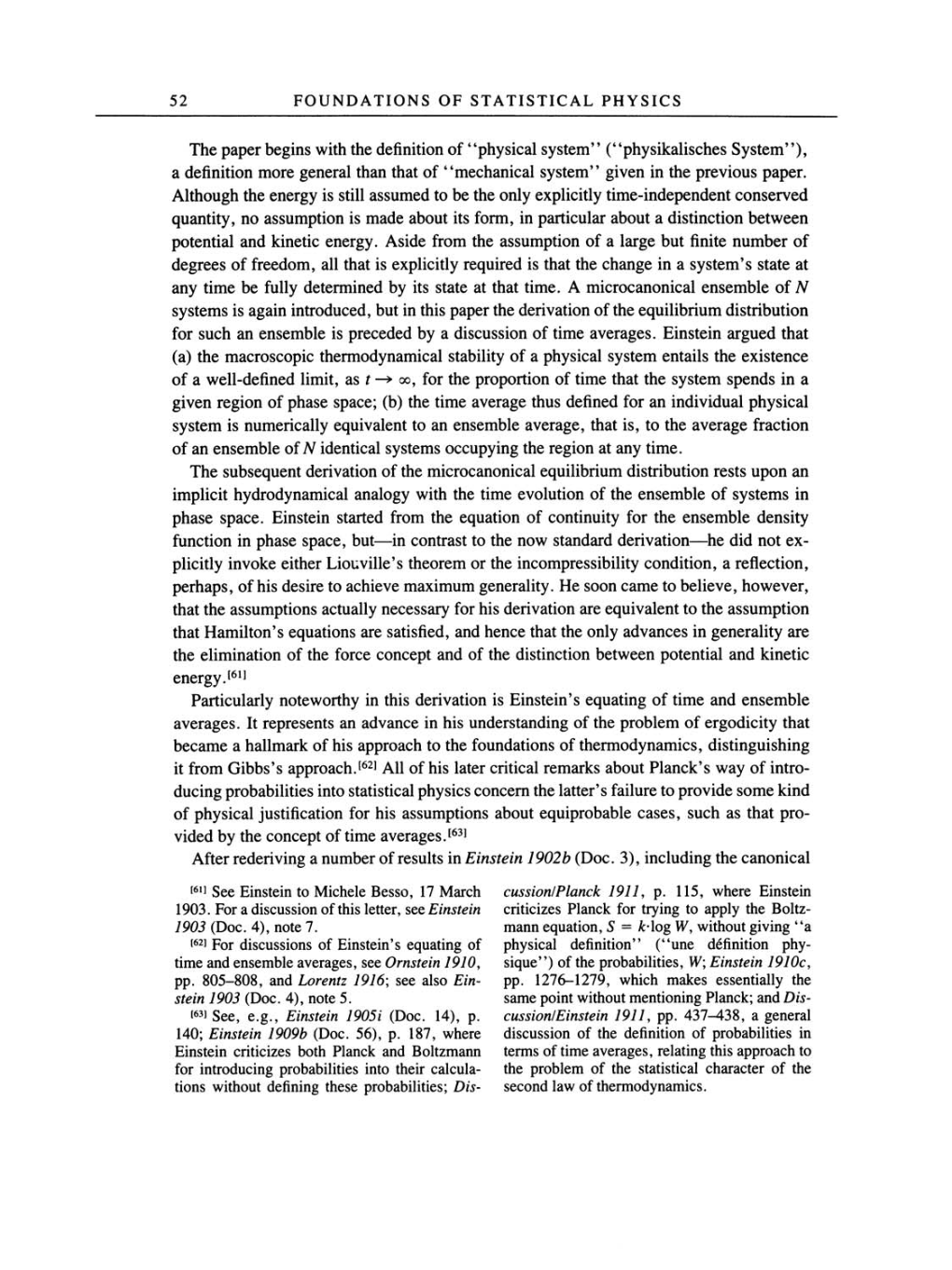52 FOUNDATIONS OF
STATISTICAL
PHYSICS
The
paper
begins
with the definition
of
"physical
system" ("physikalisches System"),
a
definition
more general
than that
of "mechanical
system"
given
in the
previous paper.
Although
the
energy
is still assumed to be the
only explicitly
time-independent
conserved
quantity,
no assumption
is
made about its
form,
in
particular
about
a
distinction between
potential
and kinetic
energy.
Aside from the
assumption
of
a
large
but
finite
number of
degrees
of
freedom,
all that
is
explicitly required
is
that the
change
in
a
system's
state at
any
time be
fully
determined
by
its state at that time. A microcanonical
ensemble of N
systems
is
again
introduced,
but
in
this
paper
the derivation
of
the
equilibrium
distribution
for
such
an
ensemble
is
preceded by a
discussion
of
time
averages.
Einstein
argued
that
(a)
the
macroscopic thermodynamical stability
of
a physical system
entails the
existence
of
a
well-defined
limit,
as
t
-
oo,
for the
proportion
of
time that the
system spends
in
a
given region
of
phase space;
(b)
the time
average
thus defined for
an
individual
physical
system
is
numerically equivalent
to
an
ensemble
average,
that
is,
to the
average
fraction
of
an
ensemble
of
N
identical
systems occupying
the
region
at
any
time.
The
subsequent
derivation
of
the microcanonical
equilibrium
distribution rests
upon an
implicit
hydrodynamical analogy
with the time evolution
of
the ensemble
of
systems
in
phase space.
Einstein started from the
equation
of
continuity
for the ensemble
density
function
in
phase space,
but-in
contrast to the
now
standard
derivation-he
did not
ex-
plicitly
invoke
either Liouville's
theorem
or
the
incompressibility
condition,
a
reflection,
perhaps,
of
his desire to achieve maximum
generality.
He
soon came
to believe, however,
that the
assumptions actually necessary
for his derivation
are
equivalent to
the
assumption
that
Hamilton's
equations are
satisfied,
and hence that the
only
advances in
generality
are
the elimination
of
the force
concept
and
of
the distinction between
potential
and kinetic
energy.[61]
Particularly noteworthy
in this derivation
is
Einstein's
equating
of
time and
ensemble
averages.
It
represents an
advance
in
his
understanding
of
the
problem
of
ergodicity
that
became
a
hallmark
of
his
approach
to the foundations
of
thermodynamics, distinguishing
it
from
Gibbs's
approach.[62]
All
of
his later critical remarks about
Planck's
way
of
intro-
ducing
probabilities
into statistical
physics concern
the
latter's
failure to
provide some
kind
of
physical justification
for his
assumptions
about
equiprobable
cases,
such
as
that
pro-
vided
by
the
concept
of
time
averages.[63]
After
rederiving
a
number
of
results in Einstein 1902b
(Doc. 3), including
the
canonical
[61]
See Einstein to Michele
Besso, 17
March
1903. For
a
discussion
of
this
letter,
see
Einstein
1903
(Doc.
4),
note
7.
[62]
For discussions
of Einstein's
equating
of
time and ensemble
averages, see
Ornstein
1910,
pp.
805-808, and Lorentz
1916;
see
also Ein-
stein 1903
(Doc. 4),
note
5.
[63] See, e.g.,
Einstein
1905i
(Doc. 14),
p.
140;
Einstein
1909b
(Doc. 56), p. 187,
where
Einstein criticizes both Planck and Boltzmann
for
introducing
probabilities
into their calcula-
tions
without
defining
these
probabilities;
Dis-
cussion/Planck
1911,
p.
115,
where Einstein
criticizes Planck for
trying
to
apply
the Boltz-
mann
equation, S
=
k.log W,
without
giving
"a
physical
definition"
("une definition
phy-
sique")
of
the
probabilities,
W;
Einstein
1910c,
pp.
1276-1279, which makes
essentially
the
same point
without
mentioning
Planck;
and Dis-
cussion/Einstein
1911,
pp.
437-438,
a general
discussion
of
the definition
of
probabilities
in
terms
of
time
averages, relating
this
approach
to
the
problem
of
the statistical
character of
the
second law
of
thermodynamics.
